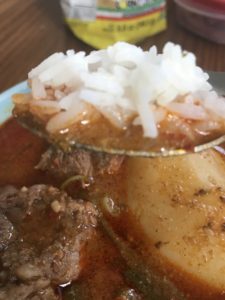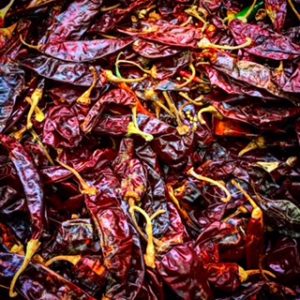On a cold, windy and rainy Sunday night I look out the window and see the wind blowing the trees from right to left, I can hear the rain falling on the roof, the scene is broken by the soft and tender voice of my mothers broken english, “mijo ya casi esta ready el Pepian”. “My son, the pepian is almost ready”. All of a sudden I feel warmth in my heart. I can smell the boiling sauce and meat, the white rice is steaming on the side, and I sit back and recount the day it took gathering the right ingredients, going through the right process and recounting of how this food unifies my family. Pepian is my favorite food because it connects me to my indigenous roots predating Columbus, brings my family together and it is not contained or restricted by borders. I Love all almost every kind of food- from greasy, cheesy pizza to healthy, steamed broccoli, but my favorite food, by far, is Pepian.
Pepian is a traditional Guatemala stew that my family has been making for decades. It can be made with chicken or beef and includes cut up vegetables alongside chunks meat. My family, prefers adding potatoes, chayote, and string beans. The sauce is made with tomatoes, toasted sesame seeds, toasted squash seeds, tortillas, and Chile Guajillo – all blended together into a thick, rich, and hearty mixture. It’s kind of like a Mayan curry or a Guatemalan version of mole and is best served with rice.
Although I have been trying to learn how to make the dish, my mom is the real master chef in our household. In Guatemala it is a tradition that all women start cooking at an early age, however, because my mother was the youngest of seven children and four sisters, she never had to learn how to cook. But when she married my father, she asked my father’s oldest sister, Tia Maritza, to teach her his favorite dishes. My Tia Maritiza shared all of the recipes that she learned from her mother, Mama Mima. Mama Mima owned a stand at one of the oldest mercados in Guatemala City and was famous for her tamales. With Tia Maritza’s guidance, my mom learned to cook all the Guatemala dishes just like my Mama Mima – including Jocon, Kakiq, Chiles Rellenos, Rice, Black beans, Platanos, and of course, pepian.
In addition to my mother’s culinary teacher, my Tia Maritza also helped my mom and me cross the border into the United States when I was just two years old. During that long journey through Guatemala, Mexico and the American South West, Tita made sure that I was safe and fed and when my mom slept, she stayed awake to keep guard. When we finally made it to the United State and my mother, father and I were reunited, Tia Maritza noticed that I was only getting fed Americanized food. My young mother, then just 22, worked hard and didn’t have a lot of time to make complicated Guatemalan dishes. She also wanted me to fit in so she gave me grilled cheese, macaroni and cheese, and French toast, which is what the other kids in my apartment building ate. My Tia Maritza, however, did not approve. She insisted that she and my mama cook a meal together every Sunday so we could enjoy decent Guatemalan food and compartir, share.
I still remember the first Sunday that I tasted Pepian. It was cold outside (well, cold for Los Angeles), but inside, my mom and my Tia were hard at work toasting seeds and tortillas and smashing ingredients in a molcajete. The different cuts of meat that went into the pepian looked delicious. Me and my cousin played in the living room, while our fathers watched a futbol game. After a couple of hours of peeling, dicing, smashing, toasting and boiling the Pepian was done. Our family sat down and started the meal by sharing stories of this magical yet mysterious food. My father and Tiia shared stories of their mama Mima cooking Pepian for her customers at the Mercado La Palmita on Thursdays and Sundays. My mom described how her cousins from a small town in rural Guatemala would tease her for not knowing how to cook Pepian. My Mexican uncle Tony said he had tried a version of pepian in Mexico, but did not learn how to appreciate Pepian until he married my Tia Maritza. As I dipped my rolled tortilla into the thick sauce I knew that I was about to eat something special, I was about to indulge myself in a culinary tradition that went back generations to a time before Columbus.
Although Guatemala Claimed Pepian as that countries national dish in 2007, Pepian originates in the Maya-Kaqchikel group[1], thus making it a Meso-American . The Maya Civilization peaked before the arrival of the Spanish. The Maya had a fully developed culture, which included a culinary tradition with dishes like the Kak’ik, a Q’eqchi Mayan turkey soup[2], Tamales, which unlike most tamales from Mexico, are wrapped in a banana leaf and have rice in the massa[3] and Pepian[4]. The original Pepian was a vegetarian dish which included pepitoria (roasted squash seeds)[5], tomatoes, and chilis. After the Spanish arrival, Mayan people and culture where threatened by aggressive, genocidal colonizers Like Pedro Alvarado[6]. During the colonial period many aspects of the Mayan culture were attacked and destroyed by the Spanish and European colonizers, but some of the traditions survived and adapted and changed overtime. Pepian was fused with newly introduced meets like chicken, pork, and beef, but it also retained it’s Mayan influence by maintaining the pepitoria as the main ingredient. The mostly working class Mayan population that had created the dish, started to only make Pepian only on special occasions like for religious ceremonies, family celebrations, weddings, and holidays because of the price of the ingredients, particularly the meat.
Because Guatemala is 39% indigenous and it is considered the biggest indigenous population in the Western hemisphere, Guatemala has claimed this dish as Guatemalan. but Pepian was cooked by Mayan chefs long before colonization and well before the modern nation state of Guatemala. Because Pepian existed before modern day national boundaries, the dish can also be found in areas of central and southern Mexico. In Mexico, Pepian is often recognized as the forefather to Mole and it is also spelled differently by replacing the e for an I,
to make Pipian[1]. In southern and central Mexico Pipian is also cooked by ethnic Mayans, just like in Guatemala. The ability of Mayan cuisine to survive colonization and resist the pressure to assimilate into national Guatemalan and Mexican identities, makes Pepian a cultural victory for the Mayan people and their 500 year resistance. Every time I take my mother to the store to pick out the ingredients for Pepian, it feels like I am playing a small part in the Mayan resistance.
Last week when I took my mom to the store I watched as she merged our present lives in the United States with our family’s Guatemalan and Mayan past. In the grocery store, she made her way to the potato aisle first. She passed by the red ones, the purple ones, and the ones shaped like fingers. She avoided the oversized, starchy Russets, and the various kinds of sweet potatoes, and she made a B-line to her potato of choice: the golden colored New Potatoes. She explains that the smaller sized, smooth New Potatoes are fresher than the others, which makes them more juicy and sweet. After carefully selecting half a dozen unblemished potatoes, she made her way to the chayote. Chayotes are a tropical fruit native to Mexico and Central America that taste a little like a cross between a potato and a cucumber. Their crunchy, yet tender texture and mild flavor perfectly absorb the flavor of the meat, spices, and seeds of the pepian stew. My mom chose four and put them in her cart near the potatoes.
As I watched my mom browse through Rancho Market’s gigantic isles- serenaded by cumbia music and a voice on the loudspeaker announcing the “descuentos”, “discounts”, I started to think about how much our lives have changed and yet, how much they’ve stayed the same. When my father first came to the United States in 1988, he said the most shocking thing was going to the supermarket and seeing so much food – isles after isles of every kind of food. At the time, Guatemala was in the midst of a civil war and food was harder to come by, but my mom says that even in height of the war, my abuela would make pepian at least once a month. Whereas in Guatemala we purchased most of the produce at open air farmers markets from mostly indigenous women wearing their trajes or traditional clothing, here our produce came from all over the world and we could use a self-checkout line if we were in a hurry or just didn’t want to talk to a human. In Guatemala, we made tortillas by hand, but here, except on the rare occasions, we purchased them from some company called Mission. Yet despite the logistical differences, the taste of the food carried our culture across time and space and across generations and borders. It linked us with our ancestors and told the story of our pre-columbian, post-colonial, post-US imperial, presently-proud immigrant lives.
After my mom finished cooking that night, she laid out the table cloth which she had purchased from ingenious weavers in Guatemala, lit the Virgin de Guadalupe candle, and called us all for dinner. As I sat next to her, my brother, and my Tia Maritza I thought about everything our family had endured for generations – colonization, civil war, border crossings, anti-immigrant sentiment. But as I rolled my tortilla and dipped it into the pepita-based sauce, I felt bien alimentado – well nourished – in body and soul.




[1] Dewitt, Dave.
“Pepian, An Ancient Heritage Recipe”. MexGrocer. Nov 22, 2009. http://blog.mexgrocer.com/pipian-an-ancient-heritage-recipe/. Accessed Mar 10, 2018
[1] France-Presse, Agence. “Guatemala’s Mayan heritage lives on in spicy pepian”. Inquirer. Sep 25, 2015.
http://newsinfo.inquirer.net/725335/guatemalas-mayan-heritage-lives-on-in-spicy-pepian#ixzz59QLGh3jC
Accessed Mar 10, 2018
[2] Giron, Rudy. “Guatemalan Cuisine: The Kak’ik”. Antigua Daily Photo. Aug 2, 2008. http://antiguadailyphoto.com/2008/08/02/guatemalan-cuisine-the-kakik/#.WqTdu1LMxqw. Accessed Mar 10, 2018
[3] Watts, Amanda. “A Guatemalan Christmas: How to Make Tamales”. Mayan Families. Dec ne6, 2016. https://www.mayanfamilies.org/blogs/entry/3694. Accessed Mar 10, 2018
[4] Rose, Natalie. “From Guate, with Pepian”. Revue. Nov 5, 2012. http://www.revuemag.com/2012/11/from-guate-with-pepian/. Accessed Mar 10, 2018
[5] France-Presse 2018
[6] Minster, Christopher. “The Maya: Conquest of the K’iche by Pedro de Alvarado”. ThoughCo. May 12, 2017.
https://www.thoughtco.com/the-maya-conquest-of-the-kiche-2136556. Accessed Mar 10, 2018
